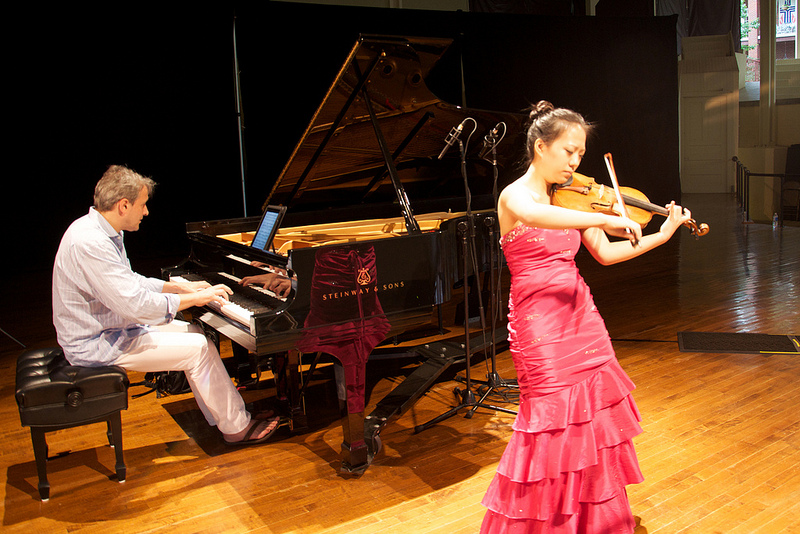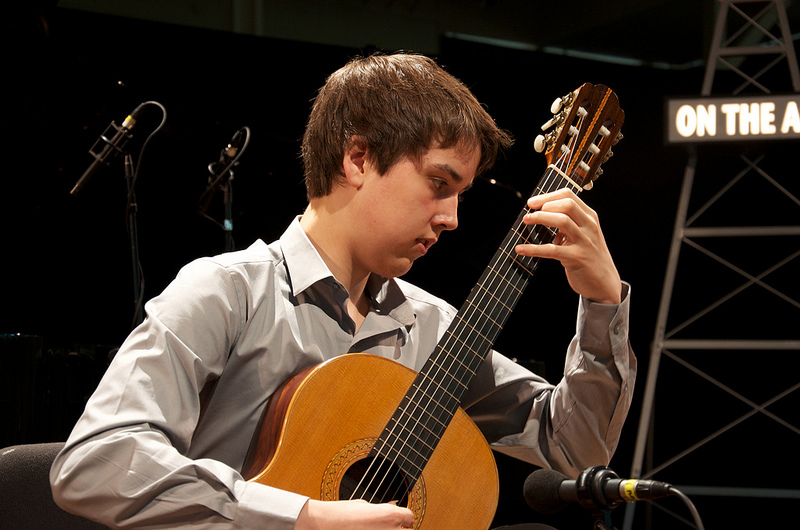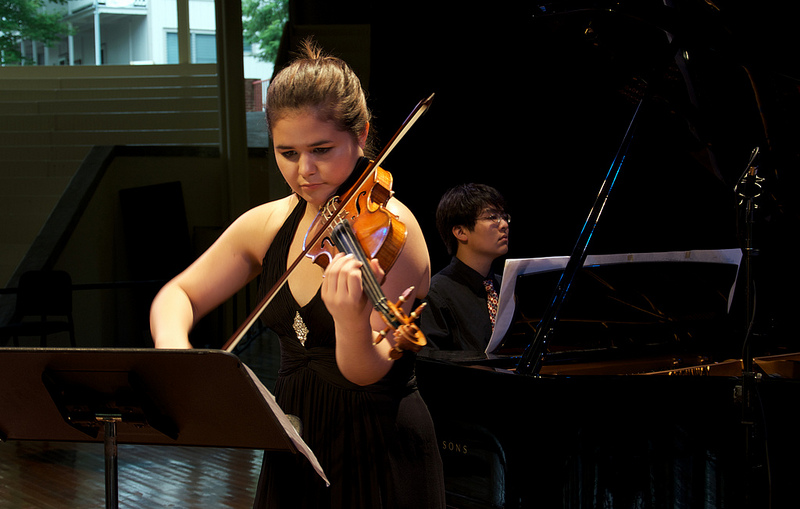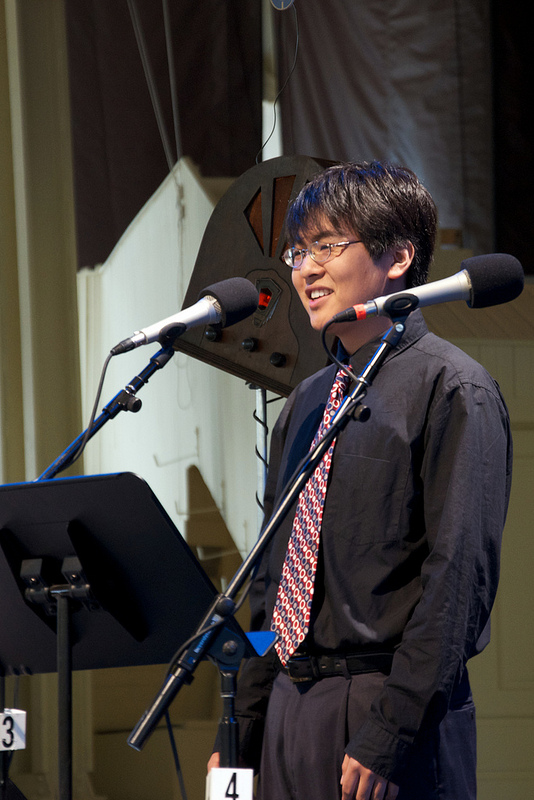Show 257: Listening Guide
From the Top’s broadcast for Show 257 was taped at the Chautauqua Amphitheater of the Chautauqua Institution in Chautauqua, New York on Friday July 20, 2012. We asked our performers to tell us about the music they performed on the show:
Laura Park, 18, violin
Waltz-Scherzo, Op.34
By: Peter Ilyich Tchaikovsky
I think that the Waltz-Scherzo is a very cute and enjoyable piece. The waltz aspect gives it lift and charm, while the scherzo aspect makes it entertaining and easy to  listen to. The hardest thing about this piece would be that it needs to stay light. It’s easy to accidentally become heavy and sound like a march. Therefore, I have to always keep aware of the piece’s character.
listen to. The hardest thing about this piece would be that it needs to stay light. It’s easy to accidentally become heavy and sound like a march. Therefore, I have to always keep aware of the piece’s character.
Post-Show Reflection: My favorite memory is during the actual live show taping when all of us were upstairs in the dressing room just hanging out and having fun and supporting whoever left to perform and congratulating whoever came back in after performing. The show itself was so much fun because the audience was very warm, laughing at all of our jokes and giving standing ovations, and the staff members were all super chill and friendly. The time spent on stage seemed to just fly by.
I believe music has the power to bring a group of people together that otherwise might not meet each other.
Xavier Jara, 18, guitar
Sonata in D Major, K.53
By: Domenico Scarlatti
My favorite part is when the voices in the bass and treble are jumping back and forth  while the haunting arpeggios play in the middle – it gets me every time.
while the haunting arpeggios play in the middle – it gets me every time.
Technically, this is by far the hardest piece I’ve every played. It’s got just about everything that guitarists fear. This is also a big reason why I play it – it really shows off just what the guitar is capable of doing.
Franz Zhao, 18, composer/piano
(performed with From the Top alum Alli Switala, 18, violin)
”Ideas”
By: Franz Zhao
My piece, “Ideas”, originally started out as several thoughts or emotions, each of them embodying its own musical fragment. Each of these fragments were embedded into the  piece, allowing for each thought to be expressed to the audience – the opening, a slow introduction consisting of a question and answer-esque line can be seen as mysterious; the somewhat quicker main theme can be interpreted as or shocking, and the rapid-paced middle section can be described as rampaging. Personally, the part I enjoy playing the most in the piece would be the quick, main theme section in 4+3/4 time. Keeping communication and staying together between the musicians is always fun, exciting, and enjoyable.
piece, allowing for each thought to be expressed to the audience – the opening, a slow introduction consisting of a question and answer-esque line can be seen as mysterious; the somewhat quicker main theme can be interpreted as or shocking, and the rapid-paced middle section can be described as rampaging. Personally, the part I enjoy playing the most in the piece would be the quick, main theme section in 4+3/4 time. Keeping communication and staying together between the musicians is always fun, exciting, and enjoyable.
The main thing that I would consider special about playing “Ideas” compared to other works I have played would be that it was one of my own works. Though I have written many works, I rarely get a chance to perform in them. Also, what made learning my own piece “special” was that I was able to interpret it any way I deemed proper or appropriate.
Post-Show Reflection: My favorite memory from the experience would probably have to be our time backstage during the show – the atmosphere was a perfect mix of  nerves, tension, and excitement. Filming our introductions was also a very interesting memory – the endless giggling, face-palming and inability to keep a straight face made it quite the experience. Since it was my first experience with anything of the sort, I did not know at all what to expect from performing on the show; I have been listening to the show for several years, but the procedure was very new to me, nevertheless. In addition, I was not expecting an audience of nearly 5,000 people, and seeing the endless sea of spectators gave me quite the rush when I first walked out. Though my nerves did not affect me much during the actual performance of my piece, they returned to me when I walked up to the microphone for my “interview”. Thoughts such as “What line do I say now?” or “I hope my voice doesn’t sound too squeaky today” rushed through my head as the interview began.
nerves, tension, and excitement. Filming our introductions was also a very interesting memory – the endless giggling, face-palming and inability to keep a straight face made it quite the experience. Since it was my first experience with anything of the sort, I did not know at all what to expect from performing on the show; I have been listening to the show for several years, but the procedure was very new to me, nevertheless. In addition, I was not expecting an audience of nearly 5,000 people, and seeing the endless sea of spectators gave me quite the rush when I first walked out. Though my nerves did not affect me much during the actual performance of my piece, they returned to me when I walked up to the microphone for my “interview”. Thoughts such as “What line do I say now?” or “I hope my voice doesn’t sound too squeaky today” rushed through my head as the interview began.
I believe that music has the power to change people’s feelings and emotions. Listeners will often subject their emotions or feelings to match those which are coming from the music. For example, Schumann’s “Scenes from Childhood” can be described as yearning and nostalgic, and it is easy for someone to envelop these emotions while listening to it, while other works such as Tchaikovsky’s “Trepak” from “The Nutcracker” and be described as very upbeat and lively and have a much happier influence on a listener.
Emily Helenbrook, 18, soprano
“O luce di quest’anima” from Linda di Chamounix
By: Gaetano Donizetti
It is my favorite piece to sing. I think about the thing that makes me happiest at that  given moment. So it changes, but what doesn’t change is the text and context of the aria in the opera – so I just think of whatever is most exciting, like going to Italy in August or something! I think of sunshine, good-looking men, and getting flowers when I sing this.
given moment. So it changes, but what doesn’t change is the text and context of the aria in the opera – so I just think of whatever is most exciting, like going to Italy in August or something! I think of sunshine, good-looking men, and getting flowers when I sing this.
The best and most special thing about this piece is the fact that Renee Fleming suggested this piece for me. She told me that it would fit me well, so I learned it immediately! Also, I wrote all of my own embellishments, so it is always to show them off!
Post-Show Reflection: I loved spending time with the other performers, especially hearing them perform for the first time and then waiting backstage with them before the show. I also enjoyed being with the staff…they are all so fun and kind! I felt deeply honored to be on the same program as the other kids who were SOOOO talented. And, the audience was appreciative and responsive which was amazing!
I believe music can change people’s lives, as it does mine; especially in times of grief. I believe that if it can bring even a moment of peace or happiness, that music has all the power in the world.
Ho Joon Kim, 13, piano
Hungarian Rhapsody, No.12 in C-sharp minor
By: Franz Lizst
This piece seems to be the most dramatic work out of all the pieces I have played. For some reason, the Hungarian Rhapsody brings the impending feeling of war, and  basically victory in the stretta. I can see the symphonic nature Lizst tried to imitate, and the capriciosso nature of the rhapsody resembles the gypsy-like theme.
basically victory in the stretta. I can see the symphonic nature Lizst tried to imitate, and the capriciosso nature of the rhapsody resembles the gypsy-like theme.
This piece is, so far, the most challenging piece I have ever played. Not only does it demand technical virtuosity, but also profound thought on ways to play the piece. It sounds like a written-out improvisation, so making the piece sound “naturally improvisational” was difficult. Also, it was difficult to play every single note in the runs of the stretta.



